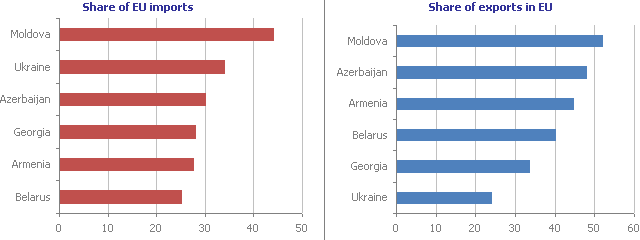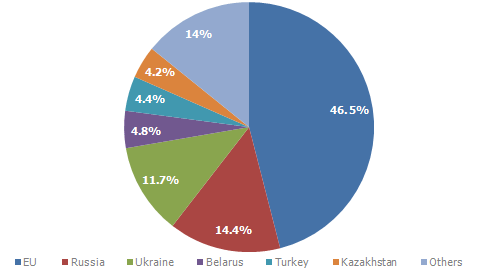ADEPT | Gagauzia 2016 | Presidential 2016 | Elections 2015 | Bashkan 2015 | Gagauzia 2012 | Political Parties
Free Trade Area with EU: opportunities and perspectives
The progresses Moldova had made in 2010 on the European integration dimension are undeniable, and along with the political the economic ones have advanced as much. In addition to the multitude of chapters and dimensions of the potential Association Agreement (AA) with the EU, the discussions and negotiations on Deep and Comprehensive Free Trade Agreement (DPFTA)[1] are some of the most important ones. In fact negotiation on this agreement is part of the economic bloc, one of the four most important of AA that Moldova intends to get from EU. Currently, as far as it is known, Moldovan side is holding negotiations on the level of experts or consultants[2], but formal negotiations on this agreement will begin early next year.
If European integration is considered in terms of economic integration, particularly for the states of Eastern Partnership (EaP), it is clear that the Free Trade Agreement (DCFTA) is apparently a pretty distant goal for some members. Two feasibility studies ordered by[3] the EU for Armenia and Georgia showed that DCFTA could bring significant economic benefits for both countries, but “none of these two is currently able to negotiate such a broad trade liberalization and so much less to implement and support the necessary commitments”[4]. Azerbaijan and Belarus would be even further away from the negotiation on this agreement, because none of them is a WTO member. Moreover, Belarus has recently joined a Customs union with Russia and Kazakhstan, which is contrary to a free trade with the EU, while Ukraine has finally refused to do so, despite the pressures to which it was subject. Republic of Moldova, ultimately, being the only exception in this regard, given that its economic relations (particularly the commercial ones) with the EU are much more advanced. In 2009, the exports to the EU totalled about USD 670 millions and represented about 52% of total Moldovan exports (Figure 1).
Figure 1. EaP countries — the share of export / import with the EU, % of total, 2009

EU trade retrospective
Trade relations with Moldova have not been a priority for the EU in the 90s, considering that the country was a minor trading partner for the Union, with about 0.1% of its total trade[5]. The trade between the Republic of Moldova and the EU increased with the EU eastward enlargement. The EU offered Moldova more unilateral trade preferences, a Generalized System of Preferences (GSP) until January 2006 and an extensive system (GSP +) thereafter. This has allowed the duty-free export of about 22% of Moldovan agricultural products and 55% of its non-agricultural products.
In March 2008, the EU unilaterally offered Moldova the Autonomous Trade Preferences (ATP), a system that allows duty free access to the EU market for all products originating from Moldova, except some agricultural products for which certain export quotas apply. Some of these restrictions apply also to some goods that are actually important for the country’s economy and hold a significant share in total exports, as for example the wine[6]. Thus, if we take into account both the Moldovan exports into the EU and imports from it, i.e. the overall foreign trade with the EU, Moldova is on the top of EaP countries (Eastern Partnership) — with over 46% of total trade (Figure 2).
Figure 2. Moldova’s main trade partners (export / import data), 2009

Source: NBS data and author’s calculations
What a DCFTA would mean for Moldova?
Unlimited and tariff unrestricted access for all our products into the EU market, as well as for the products manufactured in the EU into our market.
It actually means that if Moldova will achieve this trade regime with the EU, its customs tariffs would further reduce guaranteeing free access to EU market for Moldovan exporters currently insured by Autonomous Trade Preferences and which is restricted by certain export quotas. It means unlimited and tariff unrestricted access for all our products into the EU market, as well as for products manufactured in the EU into our market. For exporters the benefit is an unlimited access to the EU market and predictability in business and, why not, foreign investments in productive activity. For importers, the advantage will be a maximum access to international distribution networks and launching international business, elimination of any barriers and a viable mechanism for resolving any possible litigations. For consumers, ultimately, this means a much wider range of products at lower prices. Additionally, a quality control and oversight over internal market will also be introduced, which currently far from being perfect. Entry into force of such an agreement involves getting gradually rid from all sorts of duties — first of all, the customs ones. Certainly the state budget revenues will be reduced following the elimination of such duties. However, we have to take into account that the benefits are greater than costs.
Quality standards and problems will be the “Achilles heel” in the negotiations…
More or less, and that is for our good, there is little problem on harmonization of local legislation with the acquis communautaire, but unfortunately reform implementation is still far from perfect. There are no problems with the harmonization of legislation, but rather with the implementation of reforms. A particular attention should be paid to the observance of the EU sanitary standards by Moldovan manufacturers. It is not excluded that “we will stumble” in negotiations when the quality of products will be discussed, in particular the agro-industrial ones. Additionally, we should not forget that the EU is the largest world importer of agricultural products, but they must be of high quality, and to this end we have to establish a rigorous control of agricultural products in order to comply with norms on the EU market. However, the low quality of some groups of Moldovan products does not allow massive reorientation of exports towards the Western markets. That is on the one hand, and on the other — the local managers are probably not aggressive in promoting their products and invest too little in marketing segment, where just only 1–3% of turnover is allocated. Internally, there should be held as many consultations with business people as possible to explain them the advantages of this regime.
The time challenge of a DCFTA…
Usually, when certain preconditions are met, the negotiations on DCFTA are also launched. As it is known, the negotiations process itself takes between 1 to 3 years, then the final version of the agreement is signed, and its gradual implementation begins, for a period to be negotiated individually for each area. Generally, it takes around several years (5–10) — since signing the Agreement and until full liberalization in all areas (although for some products and services this may be much shorter).This gradualism is important to allow adequate adaptation and adjustment of local norms to the EU ones. For example, Macedonia has signed such an agreement back in 2001, and only in 2010 its gradual implementation ended. Finally, the good ability and skill of the Government (as well as the civil society and private sector that are no less responsible) will be tested in these negotiations, and Moldova’s European future will depend on their success.
- ↑ DCFTA — Deep and Comprehensive Free Trade Agreement
- ↑ Although on November 11, 2010 a governmental RM delegation in Brussels has already proposed to EC and Action Plan on actions to be accomplished in order to negotiation DCFTA
- ↑ Maryla Maliszewska (ed.), “Economic Feasibility, General Economic Impact and Implications of a Free Trade Agreement Between the European Union and Armenia / Georgia”, CASE Network Reports no.79–80, 2008
- ↑ European Commission : Trade : South Caucasus (Bilateral relations) [01.08.2010]
- ↑ Paul Ivan, Cristian Ghinea, “Eastern Partnership — instructions — Republic of Moldova as an opportunity”, Romanian Centre for European Policies, Policy Memo, September 2010
- ↑ Recently, however, the European Commission rose by 80% the export quota for Moldovan wines into the Community market for 2011RO
|
2011 2010 [2] 2009 2008 2007 2006 2005 2004 2003
|
Macroeconomy Public economy Finances and banking Strategies and economic development Social economy Business climate Agro-economy Transnistria: economic issues
|


